AI-generated content is already all around us as many businesses and individuals embrace AI to create more content quickly.
However, despite all its benefits, purely AI-generated content often leaves something to be desired, and that’s the human touch.
This is why it is critical to humanize AI content as much as possible. The combination of human creativity and AI-powered efficiency often proves to be just what you need to gain a stark edge over your competition.
Striking this perfect balance isn’t as difficult as it may seem, provided you’re familiar with some tricks and best practices – which is where we step in.
In this article, we’ll share the top 10 strategies for making your AI content feel more human and relatable to your audience, helping you quickly cut through the noise of the oversaturated market.
Let’s go!
Why Humanize AI Content?
Before we get to the juicy bits, let’s answer the question that’s bugging many prospective AI users:
Will using AI to generate content get me penalized?
In short – no.
This is a very controversial question, as many feel that using AI to create content is cheating.
While this reasoning leads to the conclusion that Google and other search engines will punish you for using AI, the answer is actually much more complex.
Google’s March update, which aimed to enhance the quality of Search across levels, targeted many websites with AI-generated content, but it wasn’t the AI that got them removed.
It was the poor quality of their content, as it lacked value, originality, and accuracy, making it inadequate for Google’s content standards.
This brings us to another essential question: Why do you need to humanize AI content in the first place?
There are several reasons why you should focus on humanizing AI content, but here we’ll list the top 3 ones:
1. Better audience engagement
You should always keep in mind that your target audience consists of humans who prefer content that is:
- Relatable
- Contextually relevant
- Nuanced
- Capable of resonating with them on a both emotional and intellectual level
And while modern AI models have come a long way, they are still incapable of mimicking the human experience to perfection.
As a result, purely AI-generated content often seems generic and empty of real meaning regardless of the actual value it provides, which can be very off-putting for your audience.
2. Avoiding being flagged as spam
As mentioned above, poor-quality content can get you removed from Google and other search engines.
Content created by AI is usually generic – especially if you don’t know how to make the correct prompts – and can even be inaccurate, as the quality of AI outputs depends entirely on the data you feed into the engine.
If the AI model has access only to outdated, biased, or inaccurate data, it will translate to the content it delivers, as AI is still incapable of advanced reasoning.
As a result, solely relying on AI can easily get you penalized as search engines can easily recognize invaluable or inaccurate content that doesn’t follow their guidelines, making the human touch imperative here.
3. Standing out from the crowd
If you’re looking to create a unique brand, you’ll need human writing to help bring your original voice, tone, and brand personality closer to home.
Namely, original brands that manage to connect on a deeper level with their audience have much higher chances of getting more conversions and improved retention rates.
And since AI engines cannot detect emotional nuances or comprehend complex situations, you’ll have to go the extra mile with your content to ensure that it’s relatable and capable of provoking adequate emotional responses from your audience.
10 Easy Ways of Humanizing AI Content
You can apply various techniques and strategies to humanize AI text and make it more relevant to your audiences.
Here, we’ll share the 10 tactics we’ve tested and tried repeatedly, and they have never failed to deliver results.
The best part?
They’re all super easy to implement, as you’ll soon find out.
1. Choose an AI content creation tool wisely
The first step to creating high-quality AI content is finding the right AI content creation tool.
Various platforms are available today, but despite being powered by AI, they do not work the same way.
When deciding, you should focus on tools like Team-GPT that ensure the content you’ll get is of top quality.
Namely, Team-GPT helps organizations produce relatable, humanized content by:
- Integrating various AI models into a single platform—This way, you can switch between them and use the one that best fits your use case.
- Enabling collaboration between team members—As a result, the whole team can participate in creating and editing content by designing and sharing prompts, leaving comments, sending messages to team members, and more.
- Letting you create prompt libraries—This enables your team to easily instruct AI models to give them the output they need, as they’ll have access to custom prompts tailored to your organization and your most common use cases.
These features combined allow for creating content quickly and efficiently by harnessing the power of AI while making it look and feel like it was created by humans.
Here’s how you can write articles in about 3 minutes inside of Team-GPT alongside your team:
2. Have human content editors
This one is a no-brainer.
Regardless of how advanced AI models have become, leaving them unsupervised and relying only on them for content creation doesn’t usually end well.
AI is still incapable of fully grasping the entire spectrum of human emotions and often fails to understand more complex and nuanced contexts, which is why AI-generated text can feel soulless.
However, this doesn’t mean you should completely give up on the idea of leveraging AI – all it takes is combining AI with human writers and editors.
Having humans review and add their personal touch to AI-generated content provides you with the best of both worlds:
- You’ll be faster and more efficient in creating content, as AI can analyze and filter data and deliver content based on it much quicker than any human.
- Your content will resonate with your audience, as having actual writers add their touch will result in more relevant and authentic content pieces.
So, after generating content with AI, simply have a human review the material to ensure it maintains authenticity and doesn’t sound too mechanical.
Small things like fine-tuning sentence structure, tone, and flow or sprinkling some humor and witty remarks here and there help content sound more organic and genuine.
With Team-GPT, for instance, you can have the entire team work on editing and tweaking AI-generated content on the spot.
The platform’s Pages and Edit feature enables you to summarize or improve content, fix grammar and spelling, reorder and replace blocks of text, and more, all within a shared, intuitive workspace that lets every team member make their original contribution.
3. Include human fact-checkers
AI is not infallible.
In fact, the accuracy and relevancy of its results depend on the data it’s been trained on.
Therefore, if the AI model you use doesn’t have access to the freshest data, you can’t expect its output to be any good, resulting in content that will entirely miss the point.
Moreover, AI doesn’t always understand the context of the prompt or task you’ve given it, which can lead to rather unexpected and unwanted outcomes.
This means you should always have a team of fact-checkers ready to double-check all relevant information.
Another way to prevent mistakes and bias while ensuring that the content you produce is human-like and authentic is to do your own research in addition to relying on AI.
This approach provides you with a unique, human point of view on the topic, allowing you to create content that is personal enough to appeal to your audience.
4. Leverage highly personalized prompts
When it comes to AI, prompting it correctly is half the job done.
The more specific and detailed your prompts are, the better the chances that the AI will deliver the kind of results you want, reducing the need for additional editing.
In Team-GPT, you can create, store, and share prompt templates to customize your AI models’ responses, making sure they best suit your use cases and needs.
With these custom prompts, you can achieve a variety of things, including:
- Creating personas to get AI into a specific role, writing style, and tone of voice you need for specific content types.
- Providing your team with easy access to tailored prompts they use the most in everyday work ensures brand voice consistency and boosts productivity.
- Streamlining AI’s ideating, writing, and editing process so that it fits your specific needs, brand voice, overall writing style, etc.
As a result, the content you create using AI will be much more personal and human-like than what you’d get by using generic prompts.
5. Ensure that it follows SEO guidelines
Although this isn’t as closely related to the human touch as some other tactics listed here, it’s important to note that all content you produce—AI-generated or not—must adhere to Search Engine Optimization standards and guidelines.
So, when creating content, make sure you:
- Use relevant keywords – However, it’s not enough to just cram keywords into your content regardless of context and readability, as this might backfire. Try to incorporate critical keywords only where they fit and matter.
- Include title tags and meta descriptions. Search engine crawlers pay close attention to these, so don’t disregard them.
- Take care of technical SEO – Things like mobile optimization, loading speed, etc., can also affect your SERP rankings.
Bonus tip: You can actually use AI to improve SEO practices.
With Team-GPT, you can customize Chat GPT and other AI models to fit your organization’s specific needs and then use those tailored versions for quicker and more precise:
- Keyword research.
- Keyword clustering at scale.
- Drafting SEO article briefs.
- Sitemap generating.
6. Make it personal
One way to humanize AI content is by adding a human perspective to your writing.
There are several ways to achieve this:
- Storytelling—People have always responded well to stories, which is why they are such a huge part of the human experience. Incorporating real-life examples, anecdotes, and similar narratives can help make your content more relatable and readable, creating a more meaningful connection with your readers.
💡 Example of storytelling: “When Sarah first started her small business, she was overwhelmed by the complexity of managing everything from marketing to customer service. She often felt like she was missing opportunities. But then she discovered how AI could automate many of these tasks, giving her more time to focus on what really mattered—building relationships with her customers. Now, with just a few clicks, she can create content that speaks directly to her audience’s needs, and her business has never been stronger.”
- Leveraging empathy and emotion—AI-generated content is often too factual and dry. Acknowledging the audience’s struggles and emotions or reflecting on their issues can make content resonate with readers more easily.
💡 Example of an empathetic sentence: “I understand that navigating this process can feel overwhelming sometimes, but you’re not alone—many others have felt the same way. We’re here to help you every step of the way.”
- Using humor – Humor can help make content more enjoyable and dynamic across levels, so don’t shy away from using it whenever appropriate. It also enables you to break down barriers between you and the reader, making them feel like they’re engaging with an actual person rather than a faceless brand.
💡 Example of leveraging humor: “We get it—trusting AI to write your content might feel a bit like letting a robot cook Thanksgiving dinner. Will it get the seasoning right? Will it even know what stuffing is? The good news is, while we can’t promise a perfect pie crust, our AI does know how to craft engaging, human-like content without burning the turkey!”
- Incorporating personal opinions – Personal views, insights, reflections, or advice based on personal experience can add depth and credibility that AI often lacks.
💡 Example of incorporating personal views: “As someone who’s spent years in content creation, I know firsthand how challenging it can be to keep up with the constant demand for fresh, engaging material. Sometimes, I felt stretched thin, trying to balance creativity with tight deadlines. That’s why I was excited to see how AI could support the process—not replace the human touch, but enhance it by handling the repetitive tasks, allowing me to focus on the bigger picture.”
7. Incorporate visuals
Humans are visual creatures.
As a result, regardless of how good, educational, or informative your content is, it might not perform as well if it’s not visually appealing.
Moreover, good visuals can make your content more readable and enjoyable, as most people nowadays don’t like handling large, uninterrupted blocks of text.
The type of images you should use greatly depends on the kind of content you’re creating.
Anything from simple images to how-to videos and infographics can do the trick, depending on the context.
The best part?
You can use AI to create captivating visuals.
With Team-GPT, for example, your team can design all kinds of images using Dall-E 3 in seconds, just like the one below.
8. Embrace your imperfections
One of the things that makes us human is imperfection.
We are more prone to making mistakes when creating content than AI and ML engines, which often deliver content that is too flawless to be relatable.
So, one of the most clever and probably most unintuitive tricks to humanize AI text is to make it imperfect.
You can do that by:
- Mistyping words.
- Adding a few minor grammatical errors.
- Avoiding overly complicated words and idioms that AI engines are more likely to use than an average human, etc.
9. Make it user-centric
When creating any type of content, whether AI or human-generated, remember who you’re creating it for.
Essentially, all content you produce should be user-lead, meaning you should focus on creating content that brings value to your audience by:
- Educating them.
- Helping them solve a problem.
- Entertaining them.
- Providing them with relevant information.
Making sure that your content meets all these requirements will improve your SERP rankings, help you build trust, and establish a lasting relationship with your audience.
10. Keep it tailored to your target audience
One of the most effective ways to humanize AI-generated content is by making it feel personal and relevant to the reader.
While AI is fantastic at generating data-driven, general content, tailoring it to your specific audience is what makes the difference between good and great.
Here are some of the things you can do to achieve it:
- Delve into your audience’s needs and pain points – Dig deep into who your audience is before crafting any content. Are they business owners juggling multiple roles, or are they marketers looking to optimize their campaigns? AI can give you a starting point, but the magic happens when you tweak that content to address your readers’ unique challenges.
- Use industry-specific language – Tailoring content also means speaking the same language as your audience. AI-generated content often uses very broad and generic terminology, but adding industry-specific terms or jargon shows your audience that you get them. The more you reflect your audience’s reality, the more human and relatable the content feels.
- Use real-life examples they can relate to – AI might provide examples, but they often lack the specificity that resonates. Tailor these examples to your audience’s world. You can even use customer testimonials and success stories to bring your point closer to home.
Start Creating Humanized AI Content Today
Hopefully, now you understand how to humanize AI content in the quickest and simplest way.
Just make sure that the AI tool you use is optimized for your needs and don’t forget to include a human in the loop and you’re good to go.
And if you want a platform that enables your entire team to work on creating and editing quality content while integrating several AI tools into a single intuitive interface, look no further than Team-GPT.
With it, you’ll be able to:
- Collaborate on editing and perfecting content in real time.
- Create prompt libraries for better efficiency and keeping a consistent tone of voice throughout your content strategy.
- Generate stunning visuals.
Intrigued?
Try Team-GPT for free and discover how easy it is to harness the power of AI with it.

Iliya Valchanov
Iliya teaches 1.4M students on the topics of AI, data science, and machine learning. He is a serial entrepreneur, who has co-founded Team-GPT, 3veta, and 365 Data Science. Iliya’s latest project, Team-GPT is helping companies like Maersk, EY, Charles Schwab, Johns Hopkins University, Yale University, Columbia University adopt AI in the most private and secure way.


